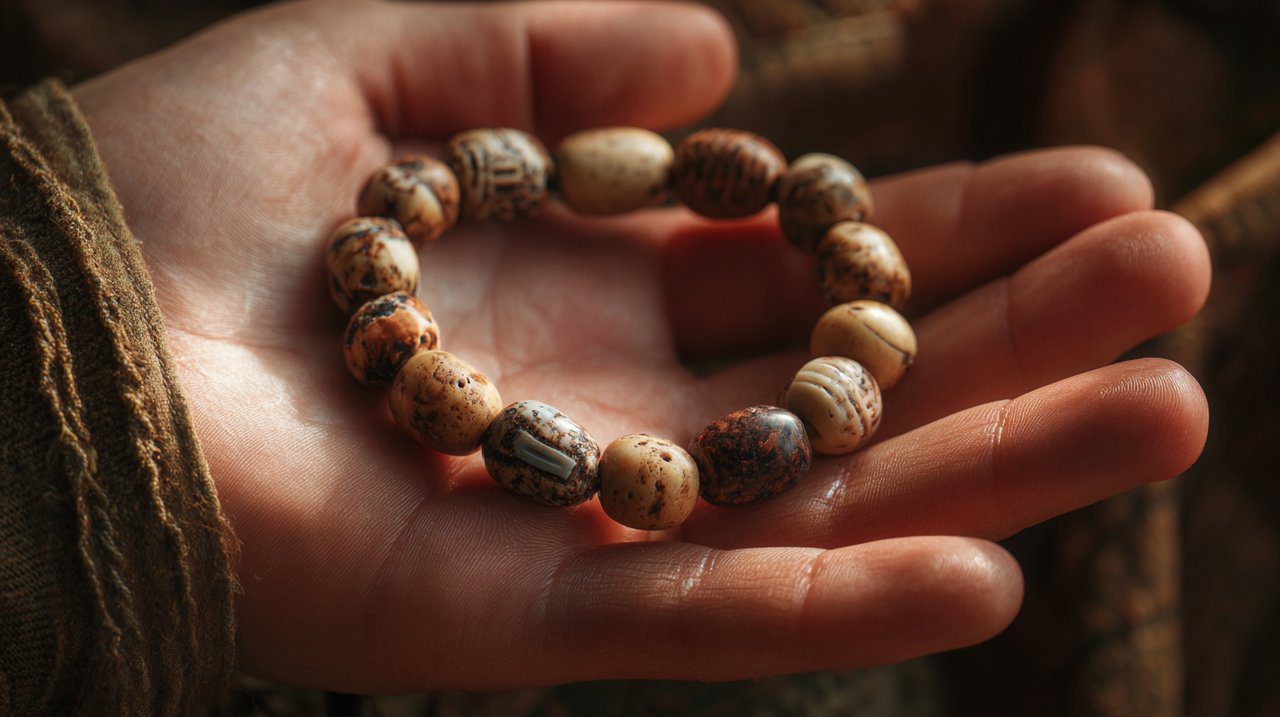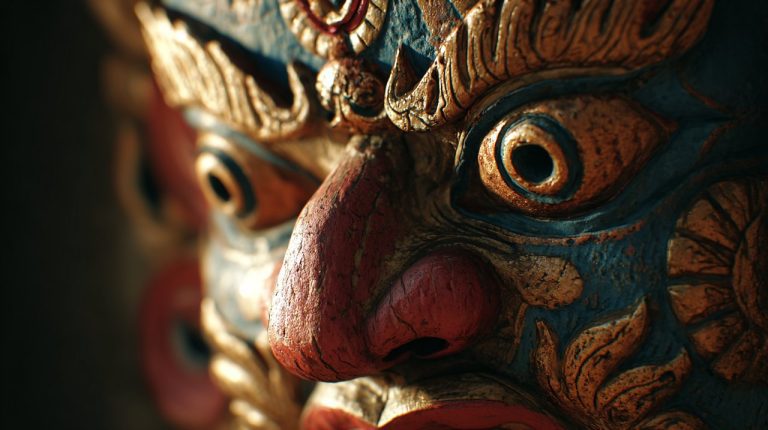Tibetan Dzi Beads: Properties, Energy, and Spiritual Significance
Some objects truly transcend their material form, becoming vessels for centuries of human belief and ingenuity. My own journey into this realm began with Tibetan Dzi beads, encountered in a serene Ladakh monastery.
It wasn’t just an aesthetic appreciation; it was an immediate recognition of their profound historical and cultural weight. This experience ignited a deeper inquiry into their mysterious origins and enduring significance.
These aren’t merely decorative stones. They are tangible conduits of a rich spiritual heritage, whispering narratives from an era when craftsmanship was intertwined with profound reverence. Our exploration here aims to unpack the intricate layers of Dzi beads, moving beyond surface aesthetics to understand their intrinsic value as both historical relics and potent spiritual anchors.

Origin and Unique Characteristics
To truly understand Dzi beads, we must move beyond their immediate visual impact. A comprehensive analysis requires us to delve into their physical attributes and their deep historical roots.
This foundational examination is crucial for discerning their enduring significance and the layers of meaning they hold.
Historical Roots
The lineage of Tibetan Dzi beads is remarkably ancient, extending far beyond much of recorded Tibetan history. Archaeological findings across the Himalayan region consistently confirm their presence as revered artifacts.
These discoveries predate the formal establishment of Buddhism in Tibet, suggesting an indigenous spiritual significance that transcends later religious influences.
These beads were never just adornments. They served as powerful talismans, central to family heritage and communal protection. Their continuous transmission across generations highlights their role as silent guardians, embodying a deep-seated belief system.
This belief system has profoundly shaped their historical and cultural trajectory, revealing a deeper story than mere decoration.
Why People Spin Prayer Wheels: Ancient Practice in Modern LifeMaterial and Craftsmanship
Authentic Tibetan Dzi beads are primarily made from natural agate or chalcedony. However, their true defining characteristic comes from an enigmatic and intricate etching process.
This wasn’t a simple carving. It was a sophisticated art form, and its precise methods are largely lost to history. This mystery only deepens their allure.
Scholarly theories propose that ancient artisans used specialized, mineral-rich solutions, likely with plant-based resists, applied to the stone. Subsequent heat treatment, possibly controlled firing, chemically altered the agate’s surface.
This resulted in the distinctive, permanently etched white or black patterns we see today. This complex process is a testament to ancient technological prowess, blending geological material with remarkable human ingenuity.
Patterns and Eyes
The most distinctive feature of Dzi beads are their ‘eyes’ – the circular or oval patterns meticulously etched onto their surface. These are far more than just decorative motifs.
They are deeply imbued with profound symbolic meaning, forming a complex language within Tibetan culture. Each pattern, from a single eye to intricate multi-eyed configurations, is believed to tell a specific story and embody distinct protective or beneficial energies.
Interpreting these patterns is a layered process. Meanings often vary subtly across different Tibetan regions or historical periods, and they are deeply interwoven with specific tenets of Tibetan Buddhist philosophy.
The clarity and distinctness of these etched designs are highly prized. They reflect not only the mastery of their ancient creators but also the potency of the symbolism they convey, acting as visual conduits for ancient wisdom.
Now that we understand their historical lineage and intricate craftsmanship, we can pivot to the core of their perceived influence: the energetic and spiritual significance attributed to them. We move from the tangible artifact to its profound metaphysical role.
Energy and Spiritual Meaning
Status in Tibetan Buddhism
Within Tibetan Buddhist culture, Dzi beads hold a uniquely sacred position, often revered as ‘living jewels.’ They are seen not merely as ornaments but as potent conduits and spiritual anchors, believed to attract blessings and channel ancient wisdom.
For centuries, spiritual masters and practitioners have considered these beads indispensable tools for meditation, protection, and accumulating merit. Their spiritual potency is frequently enhanced through elaborate consecration ceremonies, integrating them deeply into ritual practice.
Think of it like the principles of Feng Shui, where the careful placement of elements harmonizes energy flow. In a similar way, a Dzi bead is understood as a concentrated point of positive energy, constantly contributing to the wearer’s well-being and spiritual progression.
What is Feng Shui: Ancient Art of Harmonious LivingMeanings of Different Eye Counts
A key aspect of interpreting Dzi beads is understanding the significance attributed to their ‘eye’ counts. Each configuration is believed to embody a distinct energetic promise and spiritual archetype.
This forms a systematic approach to their perceived efficacy, and this detailed symbolism is crucial for discerning the specific attributes each bead is believed to confer.
Here are a few examples of what different eye counts represent:
- One-Eye Dzi: Associated with the clarity of wisdom, singular focus, and illuminating one’s path.
- Three-Eye Dzi: A highly popular configuration, symbolizing the trinity of wealth, health, and longevity, often linked to the three auspicious stars.
- Nine-Eye Dzi: Universally regarded as the most potent and sought-after. It represents comprehensive good fortune, powerful protection, and the removal of all obstacles. It’s considered an ultimate spiritual safeguard and a magnet for prosperity.
This intricate array of meanings transforms selecting a Dzi bead into a process of intuitive alignment. Individuals seek a stone whose specific energetic profile resonates with their deepest aspirations or current life phase.
These examples, of course, only scratch the surface of a vast pantheon of Dzi patterns, each possessing its own unique lore and spiritual objective.
Protection and Blessings
A cornerstone of the Dzi bead’s appeal comes from the powerful protective and benevolent qualities attributed to them. Believers widely assert their capacity to ward off negative energies, malevolent influences, and misfortune, seeing them as formidable spiritual safeguards.
I can share a personal experience here: during a period of significant personal challenge, I wore a specific Tibetan Dzi bead. While it wasn’t a magic cure, its consistent presence offered a noticeable sense of calm and enhanced mental clarity.
This anecdotal observation aligns with the broader belief that Dzi beads function as unwavering companions, providing a steady anchor amidst life’s complexities and fostering renewed resilience.
Beyond protection, Dzi beads are also widely believed to attract positive blessings, significantly enhance spiritual growth, and promote overall well-being. They are perceived as a continuous source of positive energetic support.
Now that we’ve explored their profound historical and spiritual dimensions, our next logical step is to understand how these ancient artifacts are integrated into contemporary practice. This means examining the practical aspects of wearing, selection, and care, which facilitate their connection to your personal energetic field.
Wearing and Connection
Selection and Wearing
The process of selecting a Tibetan Dzi bead is often described as intuitive, rather than purely rational. The prevalent belief is that the bead ‘chooses’ the individual.
I’ve observed this phenomenon myself: an instinctive resonance guides a person to a particular stone amidst many. This suggests a subtle, subconscious alignment between your energetic needs and the bead’s inherent properties.
Once selected, Dzi beads are typically worn in close proximity to the skin, often as pendants or bracelets. This direct contact is believed to facilitate a continuous energetic interaction with the wearer’s aura.
Consequently, the strategic placement of the bead is considered significant. Just as the optimal placement of a tool maximizes its function, understanding the specific energetic purposes associated with wearing a Dzi on a particular hand or as a pendant is crucial.
This informed approach allows you to maximize its perceived benefits and honor its traditional role.
Left or Right: Which Hand for Your Citrine Bracelet?

Cleansing and Care
Just like any revered spiritual implement, Dzi beads require mindful care to preserve their energetic integrity. Think of it like tuning a finely crafted instrument: regular cleansing is essential to maintain their perceived energetic purity and ensure they resonate optimally.
This process goes beyond mere physical maintenance; it’s seen as a vital practice for sustaining a vibrant connection with the bead.
Common traditional methods for energetic purification include:
- Moonlight Cleansing: Exposing the bead to the light of a full moon overnight is believed to gently purify and recharge its energy.
- Smudging: Passing the bead through the smoke of sacred herbs, such as sage or palo santo, is practiced to dispel stagnant or negative energies.
- Sound Cleansing: Using the resonant vibrations of a singing bowl or bell is thought to clear and harmonize the bead’s energetic field.
These rituals are crucial for re-establishing a clear energetic channel. They ensure your Dzi bead remains an effective conduit for positive energy and a steadfast spiritual ally.
Through such attentive care, your bond with its ancient wisdom is believed to be deepened and sustained.
The Enduring Resonance of Dzi Beads
My personal journey with Dzi beads started with a simple three-eye bead, acquired not from a grand collection but from a modest artisan shop. The immediate tactile connection I felt – an almost palpable warmth – served as a tangible entry point into a deeper exploration of these artifacts.
This bead has since accompanied me, a silent testament to the enduring intersection of ancient wisdom and contemporary experience.
A Dzi bead is truly a multifaceted artifact: a tangible piece of history, a potent spiritual anchor, and a persistent invitation to delve beyond superficial perceptions. It underscores a vital principle: profound significance often resides in the subtle, the ancient, and the less immediately visible.
Reflecting on that initial encounter in Ladakh, the sense of an undeniable pull towards something deeply significant wasn’t just an emotional response. It was the initial spark for an analytical inquiry into the Dzi’s essence.
It was an invitation to uncover the layers of its historical narrative, to decipher its intricate symbolism, and to appreciate its role as a steadfast anchor in our complex world. May this exploration inspire your own journey of discovery and profound connection with these remarkable artifacts.
💡 Frequently Asked Questions
Tibetan Dzi beads are remarkable etched stones with origins predating much of recorded Tibetan history, some dating back thousands of years. Authentic beads are typically crafted from natural agate or chalcedony.
Their uniqueness comes from a mysterious and intricate etching process. Ancient artisans applied mineral-rich solutions and heat to the stone's surface, creating distinctive white or black lines and patterns, most notably their characteristic 'eyes' – circular or oval shapes.
Within Tibetan Buddhist culture, Dzi beads hold a sacred position, revered as living jewels and potent conduits of spiritual energy and blessings. They are considered tools for meditation, protection, and accumulating merit, and are often consecrated through ceremonies.
Each number of eyes on a Dzi bead corresponds to specific spiritual meanings and benefits. For example, a One-Eye Dzi signifies clarity, a Three-Eye Dzi symbolizes wealth, health, and longevity, and a Nine-Eye Dzi represents all forms of good fortune, protection, and obstacle removal.
Choosing a Dzi bead is often intuitive, with many believing the bead chooses its owner. They are typically worn close to the skin. For care, regular cleansing is important to maintain their energetic purity, using methods like moonlight cleansing, smudging with sacred herbs, or sound cleansing.







